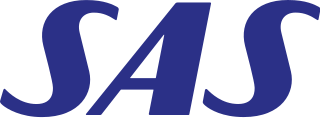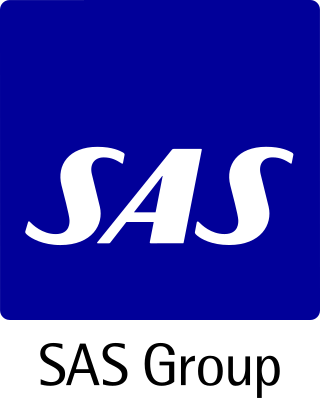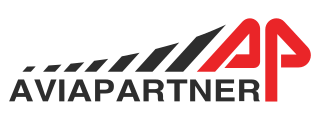
SAS Ground Handling is Europe's third-largest full-service provider of aircraft ground handling and airport related services. SAS Ground Handling is the largest ground-handling company in Scandinavia.[ specify ]

SAS Ground Handling is Europe's third-largest full-service provider of aircraft ground handling and airport related services. SAS Ground Handling is the largest ground-handling company in Scandinavia.[ specify ]
This section needs to be updated.(October 2024) |
As of 1 July 2010 SAS Ground Services is renamed to SAS Ground Handling. SAS Ground Handling serves more than 30 airports in Denmark, Norway and Sweden and has about 8400 employees. SAS Ground Handling is owned by the SAS Group. As part of the Core-SAS strategy formed by the SAS Group in February 2009, some of SAS Ground Handling operations were divested or outsourced:[ citation needed ]
On 7 March 2013 Swissport International Ltd. ("Swissport") and Scandinavian Airline Systems ("SAS") announced that they signed a letter of intent creating the basis for continued negotiations between the two companies, aiming at an agreement to transfer full ownership of SAS Ground Handling in Denmark, Sweden and Norway to Swissport. As a first step, both parties intended to establish a joint venture company to which the business and operations of SAS Ground Handling and Spirit (cargo handling) would be transferred.[ citation needed ]
As of September 1, 2013 SAS Ground Handling was divided into three divisions, SGH Norway, SGH Sweden and SGH Denmark, respectively, in preparation for the planned sale to Swissport. At the same time, Swissport, in according with the letter of intent, have bought 10% shares in each of these three divisions, while negotiations still continued.[ citation needed ]
In May 2016 SAS, however, announced its intentions to retain control of the operations at main airports. [1]

Scandinavian Airlines is the flag carrier airline of Denmark, Norway, and Sweden. Short for Scandinavian Airlines System and legally referred to as Scandinavian Airlines System Denmark-Norway-Sweden, SAS is part of SAS Group and is headquartered in Solna, Sweden.

Oslo Airport, alternatively referred to as Oslo Gardermoen Airport or simply Gardermoen, is an international airport serving Oslo, the capital and most populous city of Norway. A hub for Scandinavian Airlines and an operating base for Norwegian Air Shuttle and Widerøe, in 2011, it connected to 26 domestic and 158 international destinations.

Copenhagen Airport, Kastrup is an international airport serving Copenhagen, the capital of Denmark, as well as Zealand, the Øresund Region, and southern Sweden including Scania. In 2023 it is the largest airport in the Nordic countries.

Stavanger Airport, commonly just known as Sola, is an international airport located in Rogaland county, Norway. The airport is located 6 NM southwest of the centre of the city of Stavanger inside the neighboring municipality of Sola and it serves the Stavanger, Sola, Sandnes area as well as serves as a regional hub for southwestern Norway. It is Norway's third-busiest airport, with both fixed-wing aircraft and helicopter traffic for the offshore North Sea oil installations. In addition, the Royal Norwegian Air Force operates Westland Sea King search and rescue helicopters from Sola Air Station.
Maersk Air A/S was a Danish airline which operated between 1969 and 2005. Owned by the A. P. Møller–Mærsk Group, it operated a mix of scheduled and chartered passenger and cargo services. Headquartered at Dragør, its main operating bases were Copenhagen Airport, Billund Airport and Esbjerg Airport. The airline had offshore helicopter operations from 1975 to 1999 and had three airline subsidiaries: Maersk Air UK, Maersk Commuter, and Star Air.

Frankfurt Airport, is Germany's main international airport by passenger numbers, located in Frankfurt, Germany's fifth-largest city. In the German Aeronautical Information Publication, its name is Frankfurt Main Airport. The airport is operated by Fraport and serves as the main hub for Lufthansa, including Lufthansa CityLine and Lufthansa Cargo as well as Condor and AeroLogic. It covers an area of 2,300 hectares of land and features two passenger terminals with capacity for approximately 65 million passengers per year; four runways; and extensive logistics and maintenance facilities.
Air France–KLM S.A., also known as Air France–KLM Group, is a French-Dutch multinational airline holding company with its headquarters in the rue du Cirque, Paris, France. The group’s three major brands are Air France, KLM and Transavia. Air France-KLM is the result of the merger in 2004 between Air France and KLM. Both Air France and KLM are members of the SkyTeam airline alliance. The group's main hubs are Paris–Charles de Gaulle Airport, Paris Orly Airport and Amsterdam Airport Schiphol. Air France-KLM Airlines transported 83 million passengers in 2022.
Snowflake was a low-cost airline that operated out of Stockholm, Sweden, and Copenhagen, Denmark between 30 March 2003 and 30 October 2004. Owned by the SAS Group, it was organized as a business unit within Scandinavian Airlines, operating as a virtual airline using their crew and aircraft. Snowflake served a total 28 destinations from its bases at Stockholm Arlanda Airport and Copenhagen Airport.
An air shuttle is a scheduled airline service on short routes with a simplified fare and class structure. No exact definition exists, but the frequency is usually an hour or less and travel time is typically an hour or less. Network airlines may operate shuttle services as one-class or no-frill services, similar to low-cost airlines.

SAS AB, trading as SAS Group, is a Swedish airline holding company headquartered in Solna Municipality, Sweden. It is the owner of the airlines Scandinavian Airlines, SAS Link, and SAS Connect.

In aviation, aircraft ground handling or ground operations defines the servicing of an aircraft while it is on the ground and (usually) parked at a terminal gate of an airport.
SAS Braathens was the name of Norway's largest airline, created by a merger between Scandinavian Airlines' Norwegian division and Braathens in 2004. On 1 June 2007, the airline was integrated into mainline SAS, and changed its name to SAS Scandinavian Airlines Norge. The airline operated from its hub at Oslo Airport, Gardermoen, and was also the largest national branch of Scandinavian Airlines. SAS Braathens had its head office in Diamanten on the grounds of the now-closed Fornebu Airport in Fornebu, Bærum, Norway.
EuroBonus is the frequent-flyer program of Scandinavian Airlines. It was launched by SAS in 1992.
Transwede Airways AB, was a Swedish charter and later also scheduled airline operating between 1985 and 1998. Based at Stockholm Arlanda Airport, Transwede initially flew Sud Aviation Caravelles, and from 1987 also McDonnell Douglas MD-80s. Most charter services were operated for package tour companies to the Mediterranean.

Aviapartner, whose origins date back to 1949 under the name of Herfurth Air Services to become 'Belgavia' in the late 1960s, is a Belgian company that provides ground handling services at 72 airports in Belgium, France, Germany, Italy, Spain, The Netherlands and recently in South-Africa. Among the airports served are Amsterdam, Brussels, Milan, Düsseldorf, Rome, Nice, Toulouse and Málaga.
Norway Airlines A/S was a Norwegian airline which operated between 1988 and 1992. Focusing on charter, the airline operated two Boeing 737-300 aircraft from 1988 to 1992, after which it operated two McDonnell Douglas MD-80 aircraft, one MD-83 and one MD-87. The airline flew a single scheduled route, between Oslo Airport, Fornebu and London Gatwick Airport, at first on contract with Air Europe and from 1991 at its own expense. At its peak, Norway Airlines had 196 employees. The company struggled financially and lost more than 100 million Norwegian krone (NOK) before terminating operations, having never made a profit.
Det Norske Luftfartselskap A/S or DNL, trading internationally as Norwegian Air Lines, was an airline and flag carrier of Norway. Founded in 1927, it operated domestic and international routes from 1935 to 1941 and from 1946 to 1951. It became one of the three founders of Scandinavian Airlines System (SAS) and became one of its three holding companies from 1951, with a 28% stake and listed on the Oslo Stock Exchange. DNL was renamed SAS Norge ASA in 1996 and was merged in 2001 to create the SAS Group.

Braathens SAFE's domestic market was deregulated on 1 April 1994. Since then, any airline within the European Economic Area is free to operate any domestic or international route. Braathens rejected a proposal from the main competitor Scandinavian Airlines System (SAS) for a merger; instead the helicopter division was sold and the company listed on the Oslo Stock Exchange. New routes were opened from Oslo Airport, Fornebu to Bodø, Harstad/Narvik and Tromsø, but the routes from Bergen to these cities were terminated. International routes to Rome, Nice and Jersey were introduced. In 1996, Braathens SAFE bought Sweden's second-largest airline, Transwede, and started flying on the Oslo–Stockholm route. The following year, Transwede, with its five domestic routes, was merged into Braathens SAFE. The same year, KLM bought 30% of Braathens SAFE and the airlines started a partnership.

The history of Scandinavian Airlines System (SAS) from 1933 to 1951 covers the first attempts at transatlantic travel, the establishment of a consortium and finally the establishment of the consolidated SAS. Aerotransport, the national airline of Sweden, and Det Norske Luftfartselskap (DNL), the national airline of Norway, both started planning transatlantic routes in the mid-1930s. By 1939, negotiations were started with Det Danske Luftfartselskab (DDL) of Denmark, and by 1940 services were to begin. Because of the German occupation of Denmark and Norway, the plans collapsed. In Sweden, Svensk Interkontinental Lufttrafik (SILA) was founded to start private transatlantic flights, which commenced in 1945. Negotiations were started again, and in 1946 the consortium Overseas Scandinavian Airlines System (OSAS) was established to start routes to New York and South America.
Maersk Air was a Danish airline that operated between 1969 and 2005. Owned by the eponymous A. P. Møller–Mærsk Group, it operated a mix of scheduled and chartered passenger and cargo services. Headquartered at Dragør, its main operating bases were Copenhagen Airport, Billund Airport and Esbjerg Airport. The airline had offshore helicopter operations from 1975 to 1999 and had three airline subsidiaries: Maersk Air UK, Maersk Commuter and Star Air.